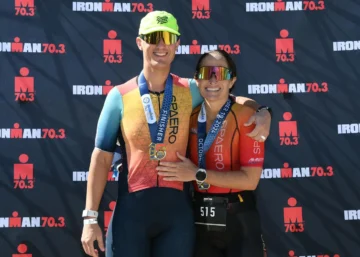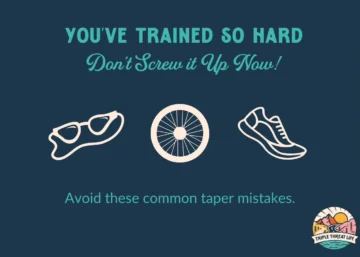
This post may contain affiliate links. If you make a purchase through one of them, I will earn a small commission at no extra cost to you. I only recommend products and services I love and use on a regular basis.
When you decide to do a triathlon, the first obstacle you will encounter is how to fit swim, bike, and run training into your life.
No matter the race distance, most athletes practice each sport 2-3 times a week. With 3 sports and only 7 days, you can see how this might be problematic…
That inevitably will mean doing two-a-days. But how am I supposed to fit two workouts a day into my busy life? You might ask.
To be honest, it isn’t easy. But then triathlon isn’t easy.
One thing to remember is that while we all have certain “nonnegotiable” obligations (work, school, family, ect.) our day to day schedule is really just a personal choice. We all have the same 24 hours to work with.
Decide what you want to do with yours.
By taking responsibility for your schedule, committing to a plan, and using effective time management strategies, you can “find time” you didn’t even know you had.
Here are a few key takeaways:
- Preparation is your best friend.
- Having a schedule is key, but leave room for flexibility.
- Sometimes, you have to think outside of the box.
By prepping ahead of time, keeping a consistent schedule, and maximizing the time you have available, you can fit triathlon training into the chaos of everyday life.
Two triathletes: Two different schedules
Meet my friend, Ciara. We first connected through Instagram and then we met in person at St. Anthony’s Triathlon earlier this year.

Ciara and her daughter, Bella, are training for the 70.3 World Championship in December, while Matt and I are training for 70.3 North Carolina in October.
Since we’re both at similar points in our training, I thought it would be fun to look at a week in the life of two triathletes.
Ciara:
- Monday- Swim + Run + Strength
- Tuesday- 1.5 hr. trainer ride
- Wednesday- Swim + Track session
- Thursday- Group ride
- Friday- Swim + 10-mile run + Strength
- Saturday- 70-mile ride
- Sunday- Off day
Total: 13.5 hours of training
Brittany:
- Monday- Off day
- Tuesday- 1:17 trainer ride + 45 min. run
- Wednesday- Swim + Strength
- Thursday- 1.5 hr. trainer ride + 40 min. run
- Friday- Swim + Strength
- Saturday- 60-mile ride + run off the bike
- Sunday- 2-hour run
Total: 13.5 hours of training
As you can see, there are some similarities and a few notable differences.
Similarities:
- We both logged 13.5 hours of training during this particular week.
- We both did several two-a-day workouts.
- We both swim, bike, and run multiple times a week.
- We both do strength work twice a week.
Differences:
- Ciara’s rest day is Sunday, and my rest day is Monday.
- Ciara did her long run during the week, while I did mine on the weekend. Also, her long run took place before her long bike ride, while mine was the opposite.
- I had two brick runs (run off the bike) while Ciara had stand-alone runs.
- Ciara’s bike ride was a bit longer than mine, and my long run was a bit longer than hers.
Both Ciara and I have triathlon coaches we work with who help design our schedules, which makes this process easier. But even if you don’t have a coach, you can still organize your workouts however works best for you.
There’s no one-size-fits-all approach when it comes to triathlon.
Most triathletes put their longest workouts (bike and run) on the weekend, because that’s typically when they have the most time available. But if you happen to work on the weekend, you can easily shift your long ride or run to a different day.
Can’t get in a long brick before work? No problem. Sometimes, you have to separate the bike and run, which allows for more flexibility as well as the added benefit of getting a bit more mileage, if that’s what you need.
That’s why I’m not a big fan of following a static training plan you download off the Internet. Don’t get me wrong. It works for some people just fine.
But having a coach who will design and structure a week’s worth of workout that are specific to you is a huge benefit for triathletes who are trying to balance training with a busy life. They can make changes and move things around when life gets in the way, you sustain an injury, or get sick.
A training plan can’t do that.
#1- Preparation is your best friend.
Efficiency is the name of the game when trying to fit training into a busy lifestyle.
Think about the things you can do ahead of time that will help you successfully execute each session within a limited time frame.
For example, make your hydration bottles the night before and keep them in the fridge so they’re ready to go for an early morning bike ride.
If you have trouble getting motivated for early morning workouts, the simple act of setting out your clothes, gear, and nutrition the night before will help ensure that you actually get up and workout instead of snoozing your alarm.
Also, multi-tasking is your friend. I like to stretch before I workout, so I eat a snack and have a drink while I use my foam roller. After a workout, I have a protein shake ready so I can drink it while I’m taking a shower before work.
TIP: I keep all my cycling gear in one bag: cycling shoes, sunglasses, heart rate strap, gloves, helmet, and bike computer, so I can grab and go. Not only does it help me get out the door faster, there’s less likelihood I might leave an important piece of equipment behind.
The night before a long bike ride, we take our bikes off the trainer, pump up tires, charge bike computers, and organize our gear bags. There’s no need to be scrambling around in the morning getting everything together while you’re still half asleep.
The same goes for swimming and running.
On Wednesday, Matt and I swim on our lunch break and do strength after work. That means he needs all of his swim gear, a towel, gym clothes, and a water bottle packed before he leaves for work at 7:30 am.
Think of the 5 P’s- Proper Preparation Prevents Poor Performance.
#2-Have a consistent schedule, but leave room for flexibility.
I’m going to drop some knowledge on you.
There’s no such thing as a perfect training block.
During the past six years, we’ve never had a training cycle that went 100% to plan. Things happen, whether it’s a work trip, you get sick, have to fulfill family obligations, ect.
Being able to adjust your schedule and adapt isn’t always easy, but it’s an important skill to learn. Chances are, at some point during a race, things won’t go to plan. Your ability to be flexible and make good decisions on the fly is what will ultimately determine your success.
For example, here’s something that happened to us a few weeks ago. We’d planned to swim on our lunch break and hit the gym after work, but a thunderstorm rolled through and the pool was closed. So, we pivoted and did our strength session at the gym during lunch and moved the swim to the afternoon.
Was it ideal? Not really, but we got it done.
Another weekend, we wanted to attend church but we had a long run planned and needed to run errands, clean the house, and meal prep for the week. It seemed like there just wasn’t enough time in the day to get it all done.
So before we left for an early morning service, we packed our running clothes, changed in the parking lot, and did our long run on a nearby trail.
TIP: I know some athletes who keep a gear bag in their car with running clothes, shoes, and extra nutrition so they can drop by the gym for a quick run or strength session at a moment’s notice.
#3-Think outside of the box.
I’m going to borrow a few examples from my friends for this one.
My friend Joey is a mechanic. After a long day in the heat working on cars, the last thing he wants to do is workout after work. So, he swims before work with a friend (accountability) to make sure he gets his workout done.
My friend Brent has several kids. Oftentimes, you will see him at the pool swimming laps while his kids are taking swim lessons.
My friend Sebastian goes to college and has a job as a medical assistant. Sometimes, that means swimming during his lunch break and running when he gets off work at 7 pm.
Two years ago, I traveled A LOT for work, and it was pretty stressful. I would be gone covering an event for two weeks at a time, and I didn’t have access to my bike.
Does that mean just skipping a week or two of training? Not if you’re getting ready for a 70.3.
Instead, we focused on what I could do. I could run just about anywhere, so my coach designed a run-focused block. I swam at a local gym and did bike-specific strength exercises.
The moral of the story is that everyone is busy. But your schedule doesn’t have to look like anyone else’s. Do what works for you.
Let’s say you have a 12-mile run, but that’s too long to get done before work. But, you can’t do it after work because you have to pick up the kids from school, make dinner, ect.
That’s fine. Break it up and do 6 miles in the morning and 6 miles in the evening.
In a perfect world, you’d want to do all your sessions exactly as planned with no interruption.
But guess what. We don’t live in a perfect world.
Sometimes, due to weather concerns (heat), durability issues (recovering from injury), or just lack of time, you have to break a long workout apart into more manageable chunks.
And that’s ok.
MINDSET MOMENT: We place priority on the things in our life that are important to us. Before signing up for a race, have some self-awareness and take time to reflect.
Are you committed to doing whatever it takes to accomplish this goal?
If the answer is maybe, no, or when it’s convenient for me, then perhaps you should hold off on clicking that register button.
Ask yourself the following question: Am I committed? or Am I just interested?
Total commitment, unwavering dedication, and long-term focus is required for excellence, in all areas of life, but especially endurance sports. Make a decision, create a plan, and then don’t let anything stand in your way.
Remember, when it comes to fitting triathlon training into a busy life:
- Preparation is your best friend.
- Having a schedule is key, but leave room for flexibility.
- Sometimes, you have to think outside of the box.
Subscribe to the Triple Threat Life newsletter!
Subscribe to the Triple Threat Life newsletter to have posts just like this one delivered to your inbox each week.
The weekly newsletter contains my musings about triathlon, random philosophical thoughts, articles that magazines didn’t want to pay me to write, and much more.
If you’re new here, I post on the blog on Tuesdays and Thursdays. Be sure to follow @bblife234 and @thetriplethreatlife on Instagram to find out when they’re live.


